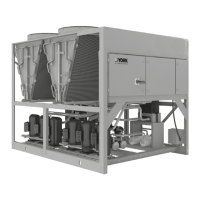JOHNSON CONTROLS
103
SECTION 6 – COMMISSIONING
FORM 150.72-ICOM7
ISSUE DATE: 10/22/2020
6
JOHNSON CONTROLS
2
FORM 150.72-CL1 (120)
ISSUE DATE: 03/06/2020
SETPOINTS ENTRY LIST
UNIT OPTIONS
Display Language
Sys 1 Switch
Sys 2 Switch
Chilled Liquid
Ambient Control*
Local/Remote Mode
Control Mode
Display Units
Lead/Lag Control*
Fan Control*
Manual Override
Current Feedback
Power Fail Restart
Soft Start**
Unit Type**
Refrigerant Type**
Flash Card Update
Remote Temperature Reset
External Evaporator Pump
YORK Hydro Kit Pump
Pump Selection
Data Log to Flashcard Enabled
Expansion Valve Type**
COOLING SETPOINTS
Cooling Setpoint
Range
EMS-PWM Max. Setpoint
PROGRAM SETPOINTS
Discharge Pressure Cutout
Suction Pressure Cutout
Low Ambient Temp. Cutout
Leaving Liquid Temp. Cutout
Anti-Recycle Time
Fan Control ON Pressure
FanDierentialOFFPressure
Total # of Compressors
Number of Fans/System*
Unit/Sys Voltage*
Remote Unit ID
* Not on all models **Viewable only
C. STARTUP
Panel checks (Power On - Both unit switch O)
1. Apply 3-phase power and verify its value. Voltage
imbalance should be no more than 2% of the aver-
age voltage. .............................................................
2. Apply 120 VAC (110 VAC for 50 Hz units) and verify
its value on the terminal block in the Power Panel.
Make the measurement between Terminals 5 and 2
of XTBC2. The voltage should be 120 VAC plus or
minus 10%. .................................................................
3. Program/verify the Cooling Setpoints, Program
Setpoints, and Unit Options. Record the values in
the Setpoints Entry List table. ....................................
4. Place the unit into Service Mode and cycle each
condenser fan to ensure proper rotation ...................
If the chiller is equipped with VSD fans,
the cycling condenser fan can not be used
to conrm phase sequence. Use a phase
checker or temporarily bypass the VSD
before starting a compressor.
5. Turn system 2 OFF and leave System 1 run-
ning. Refer to SECTION 6 – OPERATIONS (Form
150.72-ICOM6), UNIT KEYS, Option 2 for more in-
formation on System Switches. .................................
6. Connect a manifold gauge to system 1 suction and
discharge service valves ............................................
7. Place the Unit Switch in the control panel to the ON
position ........................................................................
NOTE: The chilled liquid setpoint may need to be
temporarily lowered to ensure all compressors
cycle ON.
As each compressor cycles ON, ensure that the dis-
charge pressure rises and the suction pressure de-
creases. If this does not occur, the compressor being
tested is operating in the reverse direction and must be
corrected.
8. Verify proper compressor rotation and then turn the
Unit Switch to “OFF.” ................................................
NOTE: This unit uses scroll compressors, which
can only operate in one direction. Failure to ob-
serve this leads to compressor failure.
9. Turn system 1 OFF and system 2 ON (two system units
only). Refer to SECTION 6 – OPERATIONS (Form
150.72-ICOM6), UNIT KEYS for more information ...
10. Place the Unit Switch in the control panel to the ON
position. ......................................................................
NOTE: The chilled liquid setpoint may need to
be temporarily lowered to ensure all compres-
sors cycle ON.
As each compressor cycles ON, ensure that the dis-
charge pressure rises and the suction pressure de-
creases. If this does not occur, the compressor being
tested is operating in the reverse direction and must be
corrected.
11. Ensure that the Data Logging feature has been en-
abled ............................................................................
12. Verify proper compressor rotation and then turn the
Unit Switch to OFF. ....................................................

